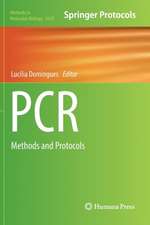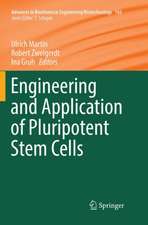Biomimetic Nanoceramics in Clinical Use: From Materials to Applications: RSC Nanoscience & Nanotechnology
Autor Maria Vallet-Regi, Daniel A. Arcosen Limba Engleză Hardback – 31 aug 2008
Recent developments in nanostructured materials have led to a shift in focus away from the replacement of tissues and towards regeneration. Nanoceramics with biomimetic properties have great potential in bone regeneration and new synthesis strategies have been developed to obtain materials with improved biocompatibility and multifunctional performance. The aim is to develop fully biocompatible implants, which exhibit biological responses at the nanometric scale in the same way that biogenic materials do. Current man-made implants are not fully biocompatible and always result in a foreign body reaction involving inflammatory response and fibrous encapsulation. Great efforts have, therefore, been made to develop synthetic strategies that tailor implant surfaces at the nanometric scale. The intention is to optimize the interaction at the tissue/implant interface thus improving quality of life for patients with enhanced results and shorter rehabilitation periods. This book deals with 'new bioceramics' for 'new applications'. Current and future applications are considered in terms of chemical composition, structure and properties. It explains the processes that (from the point of view of solid state and sol-gel chemistry) lead to better bone implants and other medical devices. The book is structured to make it useful for students of biomaterials, but also as a reference for specialists interested in specific topics. Didactic figures and schemes make it easy for under-graduates to understand and the extended bibliography is indispensable for researchers. The introductions to each chapter deal with some common fundamental concepts thus allowing the comprehension of each one independently. The first chapter describes biological hard tissues in vertebrates, from the point of view of mineralization processes. Concepts of hard tissue mineralization are employed to explain how nature works and an overview of artificial alternatives is provided. Chapter 2 details several synthesis methodologies used to prepare nano-apatites. The aim is to obtain artificial carbonated calcium deficient nano-apatites that resemble, as closely as possible, natural biological apatites. A review on synthesis methods is collected in the bibliography. Chapter 3 describes, in-depth, the biomimetic processes used to prepare apatites similar to biological ones. It focuses on hard tissue-related biomimetism and deals with nanoceramics obtained as a consequence of biomimetic processes. Valuable information about the most widely used biomimetic solutions and evaluation methods are included. The final chapter provides an overview of the current and potential clinical applications of apatite-like biomimetic nanoceramics, intended as biomaterials for hard tissue repair, therapy and diagnosis.
Din seria RSC Nanoscience & Nanotechnology
- 14%
 Preț: 943.44 lei
Preț: 943.44 lei - 14%
 Preț: 1382.07 lei
Preț: 1382.07 lei - 14%
 Preț: 1230.53 lei
Preț: 1230.53 lei - 14%
 Preț: 778.71 lei
Preț: 778.71 lei - 14%
 Preț: 1043.67 lei
Preț: 1043.67 lei - 14%
 Preț: 1118.52 lei
Preț: 1118.52 lei - 14%
 Preț: 1204.00 lei
Preț: 1204.00 lei - 14%
 Preț: 1196.74 lei
Preț: 1196.74 lei - 14%
 Preț: 1191.46 lei
Preț: 1191.46 lei - 14%
 Preț: 1159.76 lei
Preț: 1159.76 lei - 14%
 Preț: 1242.19 lei
Preț: 1242.19 lei - 14%
 Preț: 1157.61 lei
Preț: 1157.61 lei - 14%
 Preț: 1360.94 lei
Preț: 1360.94 lei - 14%
 Preț: 1266.87 lei
Preț: 1266.87 lei - 14%
 Preț: 1123.16 lei
Preț: 1123.16 lei - 14%
 Preț: 1353.49 lei
Preț: 1353.49 lei - 14%
 Preț: 1273.68 lei
Preț: 1273.68 lei - 14%
 Preț: 1307.70 lei
Preț: 1307.70 lei - 14%
 Preț: 1383.21 lei
Preț: 1383.21 lei - 14%
 Preț: 1386.51 lei
Preț: 1386.51 lei - 14%
 Preț: 1088.21 lei
Preț: 1088.21 lei - 14%
 Preț: 1089.02 lei
Preț: 1089.02 lei - 14%
 Preț: 682.86 lei
Preț: 682.86 lei - 14%
 Preț: 948.40 lei
Preț: 948.40 lei - 14%
 Preț: 1027.31 lei
Preț: 1027.31 lei - 14%
 Preț: 948.87 lei
Preț: 948.87 lei - 14%
 Preț: 950.05 lei
Preț: 950.05 lei - 14%
 Preț: 1102.77 lei
Preț: 1102.77 lei - 9%
 Preț: 922.78 lei
Preț: 922.78 lei - 9%
 Preț: 845.69 lei
Preț: 845.69 lei - 9%
 Preț: 1009.52 lei
Preț: 1009.52 lei - 9%
 Preț: 1110.74 lei
Preț: 1110.74 lei - 5%
 Preț: 1120.59 lei
Preț: 1120.59 lei - 9%
 Preț: 1241.49 lei
Preț: 1241.49 lei
Preț: 943.44 lei
Preț vechi: 1097.02 lei
-14% Nou
Puncte Express: 1415
Preț estimativ în valută:
180.52€ • 188.99$ • 149.37£
180.52€ • 188.99$ • 149.37£
Carte disponibilă
Livrare economică 15-29 martie
Preluare comenzi: 021 569.72.76
Specificații
ISBN-13: 9780854041428
ISBN-10: 0854041427
Pagini: 173
Dimensiuni: 155 x 234 x 18 mm
Greutate: 0.45 kg
Editura: Royal Society Of Chemistry
Seria RSC Nanoscience & Nanotechnology
ISBN-10: 0854041427
Pagini: 173
Dimensiuni: 155 x 234 x 18 mm
Greutate: 0.45 kg
Editura: Royal Society Of Chemistry
Seria RSC Nanoscience & Nanotechnology
Cuprins
Chapter 1. Biological apatites in bone and teeth; Chapter 2 Synthetic nanoapatites; Chapter 3 Biomimetic nanoapatites on bioceramics; Chapter 4 Clinical applications of apatite derived nanoceramics;
Notă biografică
María Vallet-Regí studied Chemistry at the Universidad Complutense de Madrid (UCM) and received her PhD at the same University in 1974. She is Professor of Inorganic Chemistry and Head of the Department of Inorganic and Bioinorganic Chemistry at the Faculty of Pharmacy (UCM). Her current research field is solid state chemistry, covering aspects of synthesis, characterisation and reactivity in oxides and bioceramics. Daniel Arcos completed his PhD on the synthesis and evaluation of bioactive glasses and glass-ceramics in 2002. He has worked previously on structural studies of silicon containing hydroxyapatites. Currently, his research is focused on nanostructured materials for biomedical applications.
Textul de pe ultima copertă
Recent developments in nanostructured materials have led to a shift in focus away from the replacement of tissues and towards regeneration. Nanoceramics with biomimetic properties have great potential in bone regeneration and new synthesis strategies have been developed to obtain materials with improved biocompatibility and multifunctional performance. The aim is to develop fully biocompatible implants, which exhibit biological responses at the nanometric scale in the same way that biogenic materials do. Current man-made implants are not fully biocompatible and always result in a foreign body reaction involving inflammatory response and fibrous encapsulation. Great efforts have, therefore, been made to develop synthetic strategies that tailor implant surfaces at the nanometric scale. The intention is to optimize the interaction at the tissue/implant interface thus improving quality of life for patients with enhanced results and shorter rehabilitation periods. This book deals with 'new bioceramics' for 'new applications'. Current and future applications are considered in terms of chemical composition, structure and properties. It explains the processes that (from the point of view of solid state and sol-gel chemistry) lead to better bone implants and other medical devices. The book is structured to make it useful for students of biomaterials, but also as a reference for specialists interested in specific topics. Didactic figures and schemes make it easy for under-graduates to understand and the extended bibliography is indispensable for researchers. The introductions to each chapter deal with some common fundamental concepts thus allowing the comprehension of each one independently. The first three chapters describe: biological hard tissues in vertebrates (from the point of view of mineralization processes); synthesis methodologies used to prepare nano-apatites and biomimetic processes used to prepare apatites similar to biological ones. The fourth and final chapter provides an overview of current and potential clinical applications in hard tissue repair, therapy and diagnosis.
Descriere
The first book on bioactive nanoceramics to unite the many multidisciplinary concepts useful for those working in bioceramics today.

















